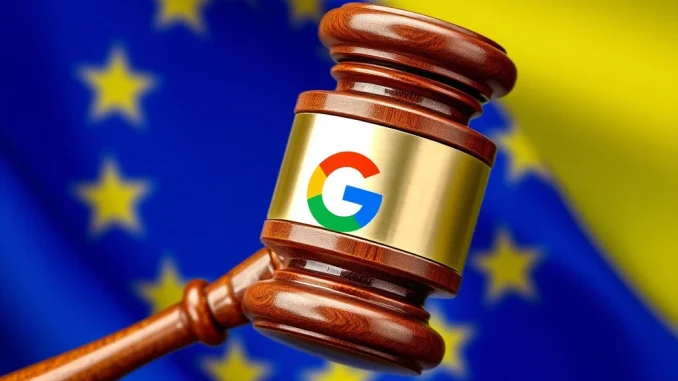
Heads up, crypto enthusiasts and businesses in Europe! If you’re involved in crypto exchanges or wallet services and are leveraging Google Ads to reach your audience, you need to pay close attention. A significant shift is on the horizon, and it’s coming sooner than you might think. Starting April 23rd, Google is set to enforce stricter crypto ad rules across Europe, all thanks to the EU’s landmark Markets in Crypto-Assets (MiCA) regulation. Let’s dive into what this means for you and the broader crypto landscape.
What are the New Crypto Ad Rules Google is Enforcing?
Imagine navigating the digital advertising space for your crypto business, only to find the rules of the game have suddenly changed. That’s precisely what’s happening in Europe. Google, a dominant force in online advertising, is aligning its policies with the EU’s comprehensive MiCA regulation. This isn’t just a minor tweak; it’s a fundamental shift in how crypto services can advertise within the European Union.
Here’s the crux of the matter:
- Licensing is Key: From April 23rd onwards, if you want to advertise crypto exchange and wallet services on Google in Europe, you must be licensed under either the Markets in Crypto-Assets (MiCA) framework or the Crypto Asset Service Provider (CASP) framework. No license, no ads.
- Google Certification: It’s not just about having a license; you also need to be certified by Google itself. This adds another layer of scrutiny and ensures that only compliant and verified entities can promote their services.
- EU-Wide Impact: These Europe crypto regulation changes are not limited to a single country. They apply across the European Union, creating a unified regulatory landscape for crypto advertising within the bloc.

Why is Google Implementing These Changes Now?
The driving force behind Google’s move is the EU’s MiCA regulation. MiCA is a sweeping piece of legislation designed to bring clarity and consistency to the regulation of crypto-assets across the European Union. A primary goal of MiCA is to enhance investor protection and ensure market integrity within the burgeoning crypto sector. Google’s policy update is a direct response to this regulatory push.
Essentially, Google is acting as a gatekeeper, ensuring that only regulated and compliant crypto businesses can utilize its advertising platform in Europe. This move is intended to:
- Boost Investor Protection: By requiring licensing and certification, Google aims to reduce the risk of investors encountering fraudulent or unregulated crypto services through its ads.
- Align with EU Regulations: Google is proactively adapting to the evolving regulatory landscape, demonstrating its commitment to compliance and responsible advertising practices.
- Promote Market Integrity: By filtering out non-compliant advertisers, Google contributes to a more trustworthy and stable crypto market environment in Europe.
What are the Potential Challenges and Concerns?
While enhanced investor protection is a welcome development, the new crypto ad rules are not without potential challenges and concerns. Legal experts and industry observers have pointed out several potential hurdles:
- Compliance Burdens for Smaller Firms: The licensing and certification process can be complex and resource-intensive. Smaller crypto firms might find it challenging to navigate these requirements, potentially creating a barrier to entry and disproportionately impacting smaller players in the market.
- Temporary Enforcement Gaps: As MiCA is still being implemented across different EU member states, there could be temporary periods where enforcement varies across jurisdictions. This could create confusion and uncertainty for businesses operating in multiple European countries.
- Impact on Innovation: Some worry that overly strict advertising rules could stifle innovation within the crypto sector. By limiting the ability of new and emerging projects to reach potential users, these regulations might inadvertently hinder growth and development.
Navigating the New Landscape of Google Crypto Ads in Europe
So, what should crypto businesses do to navigate these new Google crypto ads regulations effectively? Here are some actionable insights:
- Understand MiCA and CASP: Familiarize yourself thoroughly with the requirements of the Markets in Crypto-Assets (MiCA) and Crypto Asset Service Provider (CASP) frameworks. Determine which framework is relevant to your business model and operations.
- Initiate Licensing Processes: If you plan to continue advertising on Google in Europe, start the process of obtaining the necessary licenses under MiCA or CASP as soon as possible. Be prepared for a potentially lengthy and detailed application process.
- Prepare for Google Certification: Keep an eye out for Google’s certification process details. Ensure your advertising practices align with Google’s policies and be ready to provide the necessary documentation and information for certification.
- Review Advertising Strategies: Re-evaluate your current advertising strategies in light of these changes. Consider diversifying your marketing efforts beyond Google Ads to mitigate potential disruptions.
- Seek Legal Counsel: Consult with legal experts specializing in crypto regulations to ensure full compliance with MiCA, CASP, and Google’s advertising policies. This is particularly crucial for navigating the complexities of cross-jurisdictional compliance.
Looking Ahead: The Future of Crypto Advertising in Europe
Google’s enforcement of MiCA regulation for crypto ads in Europe marks a significant step towards a more regulated and, potentially, more trustworthy crypto advertising environment. While there are valid concerns about compliance burdens and potential enforcement gaps, the overarching goal is to protect investors and foster a more mature and responsible crypto market.
As the April 23rd deadline approaches, crypto businesses operating in Europe must prioritize compliance and adapt their strategies to the new reality. Staying informed, seeking expert guidance, and proactively engaging with the evolving regulatory landscape will be crucial for navigating this transition successfully. The era of unregulated crypto advertising in Europe is drawing to a close, ushering in a new chapter focused on compliance, investor protection, and sustainable growth within the digital asset space.



